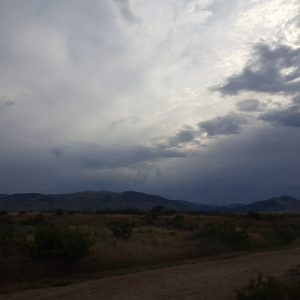
Kasha-Katuwe Tent Rocks National Monument
What is enchantment, exactly? Is it reflected in the arc of a rainbow over the Sangre de Cristo (Blood of Christ) mountain range at sunset. Or is it some kind of ether, which rises like the rich resinous incense of pinyon-juniper woodlands after a monsoon rain? Perhaps enchantment is something more elusive, like the spirits of ancient cliff dwellers who vanished before the Conquistadors even stepped foot within their ancestral canyons. And yet sometimes enchantment is impossible to ignore, like the hypnotic palpitations of a powwow drum and the flash of dancers retracing the traditions of millennia with their footsteps. Enchantment is fleeting, but grips like the first taste of red chile on the tongue.

Aspen groves and Castilleja spp.
Over a month has progressed since the start of my internship in Santa Fe, New Mexico. In that highly concentrated burst of time, my sense of enchantment has only increased as I become more acquainted with this place. My journey has taken me southward from Montana State University, to my homeland in Idaho, all the way the the Southernmost tip of the Rocky Mountains of New Mexico. I am grateful to be placed in a location at the intersection of such incredible natural and cultural beauty. The mountains, rivers, and hot springs remind me of Idaho… and yet everything else feels so foreign. I was surprised to learn that New Mexico is a biodiversity hotspot, due to its location at the intersection of the Rocky Mountains, Southwestern plateaus, Chihuahuan desert, and Great Plains. And yet in encountering the life that abounds in this arid landscape, I am not surprised at all. The flora of the mountains and sagebrush steppe comforts me with the familiarity of a common biogeographic link. But the desert is new. From the sandy mesquite of the Chihuahua, to the high sagebrush and juniper of the plateaus, the desert entices my botanical senses with an onslaught of spiny, scratchy, and surprising greenery, insistent on growing in spite of the harsh sun and erratic rainfall.

Typical Chihuahuan desert view, with Opuntia spp.

Zinnia grandiflora, looking quite happy to be growing in the sand

Apache plume (Fallugia paradoxa) graces the desert with its Dr. Seuss-like fluffs

Monk’s hood (Aconitum columbianum) grows along a lush stream in the mountains.

Alpine sunflower (Hymenoxys grandiflora) lights up the scree above treeline

Pika striking a pose – eeeeek!

Aquilegia spp. next to some gneiss rock

Dasylirium wheeleri – a Yucca look-alike with an epic inflorescence of wormy green flowers

Western Diamondback – thank God for rattles!
My internship with the BLM in Santa Fe is not only introducing me to many new ecoregions, but also to several programs critical to plant conservation in New Mexico. Under our mentor Zoe, my fellow interns and I are responsible for carrying out the Seeds of Success program and also for creating new rare plant monitoring protocols for species of critical concern. I enjoy splitting my time between these two very different and similarly rewarding tasks. With the excellent guidance of Ella, a second year SOS intern, I am collecting and scouting for seeds from a variety of native species. In New Mexico, the BLM has partnered with the Institute for Applied Ecology to forge the Southwest Seed Alliance. Together, we are helping to increase accessibility to regional seed stocks. With each seed plucked, I am become aware of its contribution to conservation of Southwestern botanical biodiversity. Even the peskiest of seeds soon scratch a place into my heart when I appreciate that they will be assisting restoration somewhere down the road. The other aspect of work, monitoring rare plants, is an immersion into the life history and conservation challenges of each individual species – many of which are lacking any demographic data whatsoever! Gathering the first insights into the predicament of rare species instills a sense of relevance and urgency to the work. Quoting Dr. Seuss inspiration, “We speak for the plants!”. After hours of scouring the desert floor for Brack’s cactus (Scherocactus cloverae ssp. brackeii), we did indeed start speaking to the plants.

A fairly large Brack’s cactus (Schlerocatus cloverae subsp. brackeii) hides from the scourge of wild horses, gas development, and disoriented botanists
After a month of enchanting experiences, I have surrendered the urge to summarize. But I would like to part with a particularly magical experience we had while camping in Chaco Canyon National Historic Park. Upon returning from an after work hike, thunder rolled into the canyon and a sprinkle quickly turned into a deluge. I took shelter in my soaking tent, bathed for the first time in a week. From my polyester cocoon, the pelting of the rain fly rose to a distant roar. Curious about the noise, I unzipped the tent and beheld three cascades rushing over the amphitheater walls, bone dry just minutes before. In its wake, the passing storm left a rainbow and breathtaking mammatus clouds, and a clear announcement of the monsoon season underway. More tales to come!

Surprise!
In exploration,
Samuel Larkin
















































